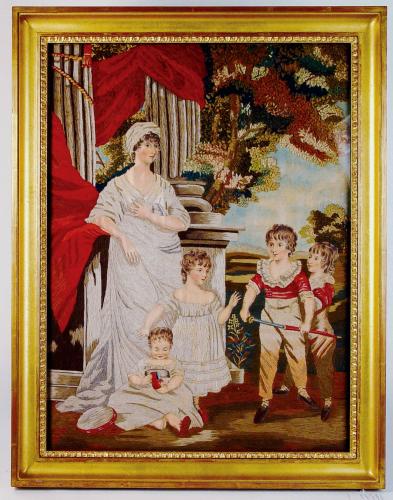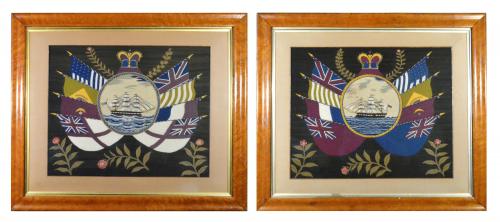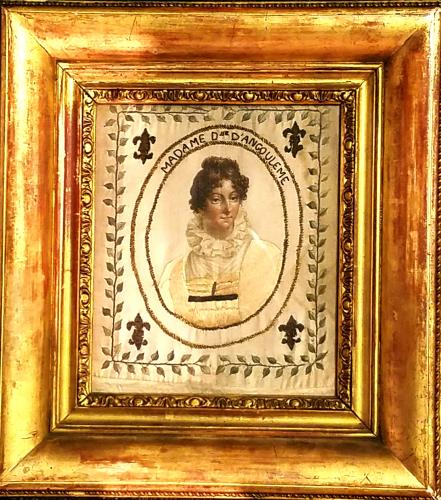

This object is eligible for a Certificate of BADA Provenance
The BADA Standard
- Since 1918, BADA has been the leading association for the antiques and fine art trade
- Members are elected for their knowledge, integrity and quality of stock
- Our clients are protected by BADA’s code of conduct
- Our dealers’ membership is reviewed and renewed annually
- Bada.org is a non-profit site: clients deal directly with members and they pay no hidden fees
Rare British Sailor's Woolwork of Tower Bridge & The River Thames, circa 1894.
The large sailor's woolie depicts Tower Bridge and various ships on the River Thames at strange angles on a colourful river within a white life preserver frame which itself is bordered with the Flags of Nations, including that of the USA. To either side of the central image are photographs of the maker and his wife, the frames a held aloft by doves, representing love, affection and constancy of husband and wife.
The bridge was opened in 1894 and this wool was probably made to celebrate that occasion.
Dimensions: 26 1/2 inches x 38 3/4 inches
Provenance: J. Welles Henderson Collection.
Reference: Illustrated in Jack Tar - A Sailor's Life 1750 - 1910, J. Welles Henderson; Rodney P. Carlisle., Page 112 for this woolie.
(https://en.wikipedia.org/wiki/Tower_Bridge)
A traditional fixed bridge at street level could not be built because it would cut off access by sailing ships to the port facilities in the Pool of London, between London Bridge and the Tower of London.
A Special Bridge or Subway Committee was formed in 1877, chaired by Sir Albert Joseph Altman, to find a solution to the river crossing problem. It opened the design of the crossing to public competition.
Over 50 designs were submitted, including one from civil engineer Sir Joseph Bazalgette. Bazalgette's design was rejected because of a lack of sufficient headroom, and design was not approved until 1884, when it was decided to build a bascule bridge. Sir John Wolfe Barry was appointed engineer with Sir Horace Jones as architect (who was also one of the judges).
An Act of Parliament was passed in 1885 authorising the bridge's construction. It specified the opening span must give a clear width of 61 metres (200 ft) and a headroom of 41 metres (135 ft). Construction had to be in a Gothic style.
Barry designed a bascule bridge with two bridge towers built on piers. The central span was split into two equal bascules or leaves, which could be raised to allow river traffic to pass. The two side-spans were suspension bridges, with the suspension rods anchored both at the abutments and through rods contained within the bridge's upper walkways.
Construction
Construction started in 1886 and took eight years with five major contractors – Sir John Jackson (foundations), Baron Armstrong (hydraulics), William Webster, Sir H.H. Bartlett, and Sir William Arrol & Co. – and employed 432 construction workers. E W Crutwell was the resident engineer for the construction.
Two massive piers, containing over 70,000 tons of concrete, were sunk into the riverbed to support the construction. Over 11,000 tons of steel provided the framework for the towers and walkways. This was then clad in Cornish granite and Portland stone, both to protect the underlying steelwork and to give the bridge a pleasing appearance.
Jones died in 1886 and George D. Stevenson took over the project. Stevenson replaced Jones's original brick façade with the more ornate Victorian Gothic style, which makes the bridge a distinctive landmark, and was intended to harmonise the bridge with the nearby Tower of London. The total cost of construction was £1,184,000 (equivalent to £122 million in 2015).
Opening
The bridge was officially opened on 30 June 1894 by The Prince of Wales (the future King Edward VII), and his wife, The Princess of Wales (Alexandra of Denmark).
The BADA Standard
- Since 1918, BADA has been the leading association for the antiques and fine art trade
- Members are elected for their knowledge, integrity and quality of stock
- Our clients are protected by BADA’s code of conduct
- Our dealers’ membership is reviewed and renewed annually
- Bada.org is a non-profit site: clients deal directly with members and they pay no hidden fees




